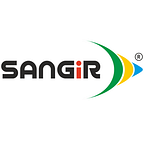PVDF piping and various joining methods for acid handling applications.
Sangir extensively manufactures and supplies PVDF piping systems globally for acid handling and is an end-to-end solution provider for your demanding applications. Our installation teams have successfully executed several projects and have many hours under their belt to help you navigate through the most intricate jobs. Sangir’s #engineered Kynar PVDF piping follows DVS 2207 & ASTM D3222 standards. PVDF piping can be joined by socket fusion, butt fusion, or non-contact IR fusion depending on the specifications. Read more before specifying the joining method for your next project.
Socket Fusion
This is a reliable process as it offers a 100% interference fit, unlike SCH80/40 vinyl products that allow for partial penetration without any need for joining aid. PVDF socket fusion fittings have a thicker wall than butt fusion which improves the pressure rating/safety factor of the fittings. Although a socket fusion joint cannot be repeated in case of an error, it allows for precise final dimensions if welding steps are followed as recommended in the manufactures technical catalog.
Typical Applications up to 110mm (4”): Chemical, Pulp & Paper, Mining, Metal Pickling, Power, etc…
Butt Fusion
This is a conventional but still the most common process for joining thermoplastics and recommend for fusing larger-diameter PVDF piping systems. A widely known advantage of the butt fusion process is that it can be repeated by cutting and re-working the joint depending on the final dimensions to achieve. It is an easier process to work with for the operator, as less material has to be heated and displaced to complete the joint. Butt fusion joints can leave a sizeable bead internally that can create turbulence in flow and must be accounted for during design. Welding tool operators are suggested to use long-leg fittings as they may find it difficult to fuse short-leg fittings due to limited room on the welding tool itself.
Typical Application up to 200mm (8”): Chemical, Pulp & Paper, Mining, Metal Pickling, Power, etc…
IR Fusion
This is a relatively newer process but is similar to butt fusion conceptually — two PVDF components walls fused to form a fine bead. This small bead is entirely free of impurities that come from the heated plate. This sophisticated process and specialized tool require rigorous training and maintenance. A standard manual IR tool designed for non-contact fusion can pose some challenges to maintaining enough distance between the heated plate and components which may lead to a cold joint or an internally collapsed ‘flower’ shaped joint.
Typical Application up to 200mm (8”): UHPW
All PVDF joints must be executed by a skilled and qualified welder. All steps recommended before and during the process are critical to achieving a perfect joint. Simple tasks such as chamfering pipe end before socket fusion and not overlooking changeover time are important in the case of PVDF. Sangir PVDF joints are tested using the below DVS standards table for each process.
1. What are PVDF Pipes Fittings?
Polyvinylidene Fluoride (PVDF) has outstanding chemical resistance to highly aggressive media from 4°C to 130 °C and is an ideal substitute for exotic alloys and FRP.
2. How to connect PVDF pipe?
PVDF can be connected using 3 methods — socket fusion, butt fusion, and IR fusion.
3. How is the PVDF pipe joined?
PVDF pipe can be joined by socket fusion, butt fusion, and IR fusion. All PVDF joints must be executed by a skilled and qualified welder. All steps recommended before and during the process are critical in order to achieve a perfect joint. Simple tasks such as chamfering pipe end before socket fusion and not overlooking changeover time are essential in the case of PVDF. Sangir PVDF joints are tested using the below DVS standards table for each process.
